The Gupta Empire was an ancient Indian empire on the Indian subcontinent which existed from the early 4th century CE to early 6th century CE. At its zenith, from approximately 319 to 467 CE, it covered much of the Indian subcontinent. This period has been considered as the Golden Age of India by historians, although this characterisation has been disputed by some other historians. The ruling dynasty of the empire was founded by Gupta and the most notable rulers of the dynasty were Chandragupta I, Samudragupta, Chandragupta II, Kumaragupta I and Skandagupta.
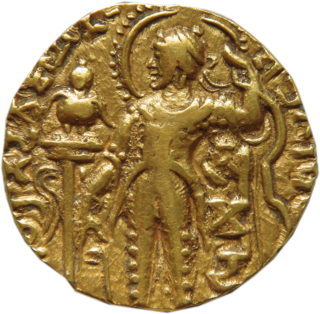
Samudragupta (Gupta script: Sa-mu-dra-gu-pta, was the second emperor of the Gupta Empire of ancient India, and is regarded among the greatest rulers of India. As a son of the Gupta emperor Chandragupta I and the Licchavi princess Kumaradevi, he greatly expanded his dynasty's political and military power.
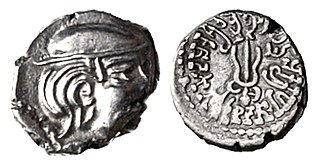
The Maitraka dynasty ruled western India from approximately 475 to approximately 776 CE from their capital at Vallabhi. With the sole exception of Dharapaṭṭa, who followed the Mithraic mysteries, they were followers of Shaivism. Their origin is uncertain but they were probably Chandravanshi Kshatriyas.
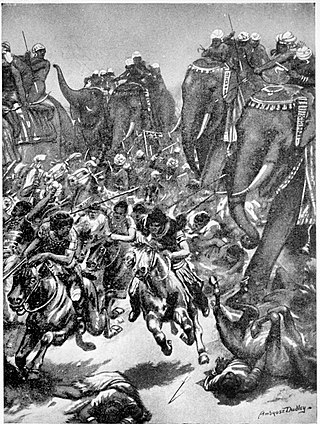
Yashodharman was a ruler of Malwa, in Central India, during the early part of the 6th century. He probably belonged to the Second Aulikara dynasty. He conquered much of the Indian subcontinent between c. 530-540 AD according to Mandsaur pillar inscription.

Eran is an ancient town and archaeological site in the Sagar district of Madhya Pradesh, India. It was one of the ancient mints for Indian dynasties as evidenced by the diverse coins excavated here. The site has 5th and 6th-century Gupta era temples and monuments, particularly the colossal stone boar with sages and scholars depicted on the body of the sculpture. The inscription stones found at Eran are important to reconstructing the chronology of Gupta Empire history. Eran or Erakina was the capital of Erakina (Airikina) Pradesha or Airkina Vishaya, an administrative division of the Gupta empire.

Toramana also called Toramana Shahi Jauvla was a king of the Alchon Huns who ruled in northern subcontinent in the late 5th and the early 6th century CE. Toramana consolidated the Alchon power in Punjab, and conquered northern and central India including Eran in Madhya Pradesh. Toramana used the title "Great King of Kings", equivalent to "Emperor", in his inscriptions, such as the Eran boar inscription.

NarasimhaguptaBaladitya was the Gupta Emperor from 495 to 530 CE. He was son of Purugupta and probably the successor of Budhagupta.

Budhagupta was a Gupta emperor and the successor of Kumaragupta II. He was the son of Purugupta and was succeeded by Narasimhagupta.
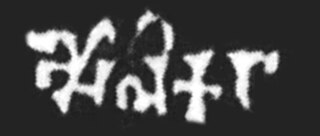
The Aulikara dynasty, was an ancient dynasty that ruled the Kingdom of Malwa between the 4th-century CE and 6th-century CE. They were based in the Malwa (Malawa) region of central India near Mandsaur, with their power center near what is now western Madhya Pradesh, southeastern Rajasthan and northeastern Gujarat. Two royal houses belonging to this clan ruled over the present-day western Malwa region of Madhya Pradesh state from c. 350 CE to 550 CE, much of it as feudatories of the Gupta Empire.
The Gwalior Inscription of Mihirakula is a Sanskrit inscription recording the construction of a Surya temple from stone on the Gopa hill of Gwalior. Though now referred with the name of Mihirakula, the temple and the inscription was commissioned by Matricheta. The original temple is lost, and the inscribed red-sandstone slab was found in 1861 by Alexander Cunningham in the porch of another temple, and published in 1861. This inscribed stone from Gwalior was moved shortly after its discovery to the Kolkata museum for preservation. Several translations of it have been published thereafter. It is damaged, its script is the northern class of ancient Gupta script and the entire composition is in poetic verse.

Kumaragupta III was a later Gupta Emperor. He succeeded his father Narasimhagupta in about 530 CE.

The Sharabhapuriya dynasty ruled parts of present-day Chhattisgarh and Odisha in India, during 5th and 6th centuries. The dynasty probably served as Gupta vassals in their early days, but became practically independent as the Gupta empire declined. The Sharabhapuriyas were succeeded by the Panduvamshis. The dynasty is known mainly from its copper-plate inscriptions, and a few coins.
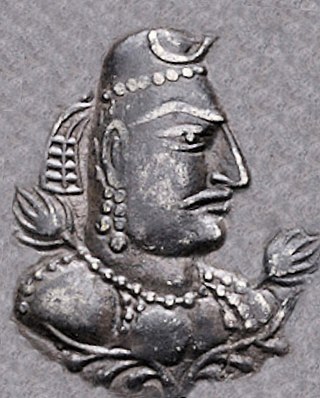
The Alchon Huns, also known as the Alkhan, Alchono, Alxon, Alkhon, Alakhana, and Walxon, were a nomadic people who established states in Central Asia and South Asia during the 4th and 6th centuries CE. They were first mentioned as being located in Paropamisus, and later expanded south-east, into the Punjab and Central India, as far as Eran and Kausambi. The Alchon invasion of the Indian subcontinent eradicated the Kidarite Huns who had preceded them by about a century, and contributed to the fall of the Gupta Empire, in a sense bringing an end to Classical India.

The Eran boar inscription of Toramana, is a stone inscription found in Eran in the Malwa region of Madhya Pradesh, India. It is 8 lines of Sanskrit, the first three of which are in meter and the rest in prose, written in a North Indian script. It is carved on the neck of a freestanding 11 feet (3.4 m) high red sandstone Varaha statue, a zoomorphic iconography of Vishnu avatar, and dated to the 6th century. The inscription names king Toramana, ruler of the Alchon Huns, as ruling over Malwa and records that a Dhanyavishnu is dedicating a stone temple to Narayana (Vishnu).

Sridharavarman was a Saka (Indo-Scythian) ruler of Central India, around the areas of Vidisa, Sanchi and Eran in the 4th century CE, just before the Gupta Empire expansion in these areas. He calls himself a general and "righteous conqueror" in an inscription, and Rajan ('King') and Mahaksatrapa in a probably later inscription at Eran, suggesting that he may have been a high-ranked officer who later rose to the rank of a King.
The Second Aulikara dynasty was a royal dynasty that ruled over the Malwa plateau, and at its peak under Yashodharman Vishnuvardhana controlled a vast area, consisting of almost all of Northern India and parts of Deccan plateau. It was the second royal house of the Aulikara clan.

The Battle of Sondani was a large military encounter fought in 528 CE, between the Alchon Hun emperor Mihirakula and a confederation of Indian rulers led by king Yashodharman of Malwa.
The emergence of the Great Kushans in Bactria and Northwestern India during the first century CE reshaped the geopolitical landscape of the region, impacting trade routes, international politics, and regional power dynamics. Economically, the Kushans served as intermediaries in trade, controlling crucial sections of the Silk Road and redirecting trade between China, India, and the eastern countries away from Parthian territory. This posed a significant economic challenge to the Parthians and positioned the Kushans as major players in international trade. Politically, the rise of the Kushans had profound implications for Iran, as it found itself sandwiched between the Roman Empire and the Kushans. The Romans recognized the strategic importance of the Kushan Empire and sought direct relations with its rulers to safeguard trade routes between Rome, China, and India. This geopolitical scenario led the early Sasanians to prioritize the conquest of the Kushan empire in their Eastern policy, eventually achieving remarkable success under Emperor Ardashir I. Following the decline of the Great Kushans, remnants known as the "Little Kushans" persisted in the Punjab region, eventually being subjugated by the Gupta Empire under Samudragupta. His inscription on the Allahabad pillar illustrates Gupta dominance over the last Kushan rulers, who were forced to accept Gupta suzerainty. Samudragupta's strategic alliances and military campaigns against the Sassanians and other regional powers solidified Gupta control over large parts of the Indian subcontinent. However, the Gupta Empire faced various challenges, including incursions by the Hunas, who posed a considerable threat to neighboring civilizations. Skandagupta's leadership and military strategy were crucial in resisting Huna advances, although the extent of damage caused by their invasions remains debated among scholars. Despite facing external pressures, internal succession issues within the Gupta dynasty, such as the question of rightful heirs, also contributed to the complexities of governance during that time.
The Hunnic invasion of the Gupta Empire was a pivotal event in ancient Indian history, facilitated by the administrative structure of the Gupta Empire, notably its feudal system. This structure allowed the Huna king to garner support from local chiefs, aiding in their invasion. The inscriptions discovered in Eran shed light on this dynamic.
The Second Hunnic War commenced with Mihirakula's ascension to power in West Punjab around 515 AD, succeeding his father, Toramana. Initially, Mihirakula's authority seemed lesser compared to his father's, as indicated by numismatic evidence. In 520, Song Yun encountered the "King of the Huns" along the Jhelum River, where the Northern Wei envoy depicted him as having a violent demeanor and being responsible for massacres, resulting in an unpleasant meeting.



















